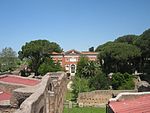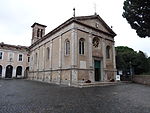Baths at Ostia

The preservation and extensive excavations at Ostia Antica have brought to light 26 different bath complexes in the town. These range from large public baths, such as the Forum Baths, to smaller most likely private ones such as the small baths (I, XIX, 5). It is unclear from the evidence if there was a fee charged or if they were free. Baths in Ostia would have served both a hygienic and a social function like in many other parts of the Roman world. Bath construction increased after an aqueduct was built for Ostia in the early Julio-Claudian Period. Many of the baths follow simple row arrangements, with one room following the next, due to the density of buildings in Ostia. Only a few, like the Forum Baths or the Baths of the Swimmers, had the space to include palestra. Archaeologist name the bathhouses from features preserved for example the inscription of Buticoso in building I, XIV, 8 lead to the name Bath of Buticosus or the mosaic of Neptune in building II, IV, 2 lead to the Baths of Neptune. The baths in Ostia follow the standard numbering convention by archaeologists, who divided the town into five regions, numbered I to V, and then identified the individual blocks and buildings as follows: (region) I, (block) I, (building) 1.
Excerpt from the Wikipedia article Baths at Ostia (License: CC BY-SA 3.0, Authors, Images).Baths at Ostia
Via degli Augustali, Rome Ostia Antica
Geographical coordinates (GPS) Address Website Nearby Places Show on map
Geographical coordinates (GPS)
| Latitude | Longitude |
|---|---|
| N 41.753888888889 ° | E 12.289166666667 ° |
Address
Ostia Antica
Via degli Augustali
00119 Rome, Ostia Antica
Lazio, Italy
Open on Google Maps










